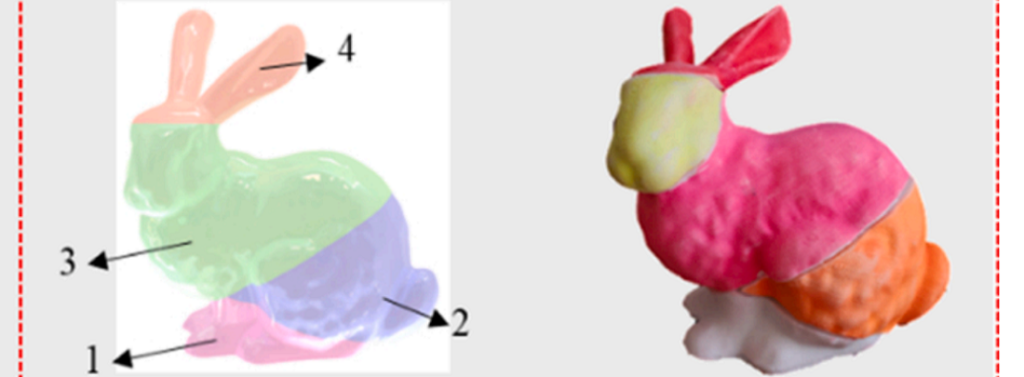Penn State Researchers Make 3D Printing More Efficient with Five-Axis Fabrication
When you 3D print objects that have overhangs, supports are traditionally added to the print before the build begins, because the overhangs are not supported by anything below and your print will very likely be unsuccessful. But a lot of research has gone into finding a way to print parts with overhangs without having to rely on supports: it’s time-consuming to remove them, and, in the end, all you have is a lot of wasted material. A pair of researchers from Penn State have developed a faster, more efficient way to print these kinds of parts without having to use as many supports. The doctoral candidates, Xinyi Xiaoa and Sanjay Joshi, recently published a paper on their work, titled “Process planning for five-axis support free additive manufacturing.”
The abstract states, “Traditionally Additive Manufacturing (AM) is a two-dimensional layer-by-layer material deposition process which requires building the support structures along with the build of the desired model. Removal of the support structures is costly and time-consuming, especially for metal parts. Using a five-axis deposition machine has the potential to build structures without the need for supports. However, there is a lack of automated process planning software to support the full use of five-axis machines. This paper introduces an automated method that allows reorienting the part during the build using a five-axis machine. The reorientations still allow the part to be built using traditional planar deposition but without the use of supports. This requires that the part be decomposed into sub volumes, such that each sub volume has its build direction and can be built with planar layers without support structures. This paper presents algorithms to determine the sub-volumes, their orientations, and sequence, which form the major components of the process plan for manufacturing. The process plan is generated by sequencing the decomposed volumes while ensuring a lack of local collision with previously deposited volumes. An added benefit of this automated process is the ability to evaluate the feasibility of building the part in a support free manner. This can provide feedback to the designer on the support free manufacturability of the part. Examples illustrating the methodology and establishing the viability of the decomposition strategy are presented to verify the effectiveness of the algorithms.”

3D printed rabbit model with support structures. Image courtesy of Instructables (In-House Art)
Their idea is a 3D printer that uses either an extrusion arm or a movable build plate to turn the part in different directions in 3D space while they’re being printed; this essentially makes every surface “flat” during extrusion. By adding an additional axis to the printer, the build process becomes more efficient, and wastes less material since supports aren’t needed.
The researchers wrote, “Removal of the support structures is costly and time-consuming, especially for metal parts.
“Using a five-axis deposition machine has the potential to build structures without the need for supports. However, there is a lack of automated process planning software to support the full use of five-axis machines. [We introduce] an automated method that allows reorienting the part during the build using a five-axis machine.”
The focus is on a new predictive print preparation model, which speeds up the process of preparing objects to be printed on a five-axis system. It works by cutting models into separate pieces, each of which is printed on a different axis. Take a look at the 3D printed rabbit above: the feet are on one axis, while the tail is another, the torso is a third, and the ears are another axis. Using the Penn State research team’s process, the amount of support material can be majorly reduced, and even totally removed.
Unfortunately, you aren’t likely to find a lot of 5-axis 3D printers available for purchase that come in a desktop or even professional size, so you’ll still have to slog through removing your support materials. But this is definitely a step in the right direction.
“Large metal components, using traditional additive manufacturing, can take days and waste lots of materials by using support structures. Additive manufacturing is very powerful, and it can make a lot of things due to its flexibility; however, it also has its disadvantages,” the researchers concluded. “There is still more work to do.”

The printer prints as much as it can at a certain axis and then turns slightly to reduce overhang and supports.
(Source: Gizmodo / Images: Penn State unless otherwise stated)
Subscribe to Our Email Newsletter
Stay up-to-date on all the latest news from the 3D printing industry and receive information and offers from third party vendors.
Print Services
You May Also Like
Low-cost “Suzy” Polymer Powder 3D Printer is Faster and Cheaper than Past Models
Polish laser powder bed fusion (LPBF) firm Sinterit has released a follow-up to its predecessors, Lisa and Nils, called Suzy, a $19,490 printer equipped with a 30W fiber diode laser....
India’s $58M Space Fund Is a Boon for AM Innovation
India’s space industry is picking up serious momentum. With a projected $44 billion space economy by 2033, the country is aggressively expanding its capabilities, fostering private-sector participation, and reducing its...
Japanese Advanced Manufacturing Capabilities Grow in Europe with Sodick’s Purchase of Prima Additive
The global economy is currently undergoing a reshuffling in terms of what gets manufactured where. In large part, this trend is being driven by new geopolitical alliances and the need...
Bosch Invests €6M into Serial Auto Part 3D Printing
German industrial conglomerate Robert Bosch GmbH, the world’s largest supplier of automotive parts, has announced a new investment into Nuremberg, Germany additive manufacturing (AM) facility. The nearly €6 million in...




























